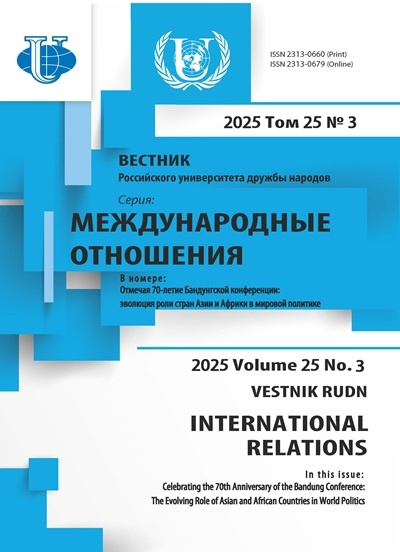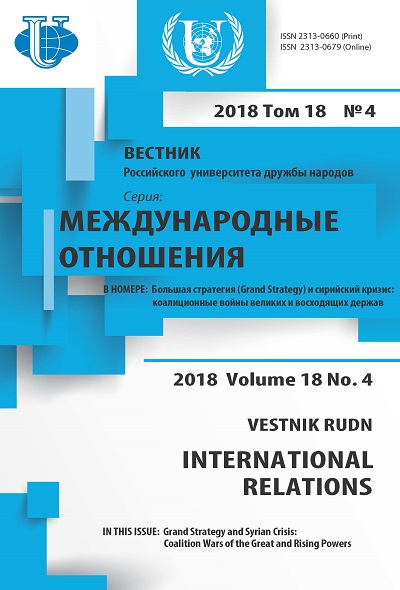Приоритетные направления российской и китайской помощи в целях развития странам Азии и Африки: сравнительно,сопоставительный анализ
- Авторы: Дегтерев Д.А.1, Ли Я.2, Трусова А.А.1, Черняев М.С.1
-
Учреждения:
- Российский университет дружбы народов
- Институт мировой экономики и политики Китайской академии общественных наук
- Выпуск: Том 18, № 4 (2018): Большая стратегия (Grand Strategy) и сирийский кризис: коалиционные войны великих и восходящих держав
- Страницы: 888-905
- Раздел: МЕЖДУНАРОДНЫЕ ЭКОНОМИЧЕСКИЕ ОТНОШЕНИЯ
- URL: https://journals.rudn.ru/international-relations/article/view/20330
- DOI: https://doi.org/10.22363/2313-0660-2018-18-4-888-905
- ID: 20330
Цитировать
Полный текст
Аннотация
Предметом данного исследования являются приоритетные направления (как географические, так и отраслевые) международной помощи, оказываемой Россией и КНР странам Азии и Африки. Авторы проводят сравнительный анализ основных реципиентов помощи двух стран, а также ее основных секторов за 2011-2014 гг. Методологическая основа данного исследования строится на принципах достоверности и научной объективности. В исследовании применен метод сравнительно-сопоставительного анализа, включающего элементы как количественного, так и качественного анализа. Авторы показывают те методологические вызовы, которые стоят при сборе статистических данных и их сопоставлении по потокам помощи новых доноров. Используются данные о международной помощи КНР (реципиенты, направления, объемы), представленные в проекте AidData. Данные о международной помощи России другим странам частично представлены в статистике ОЭСР, однако они представляют собой только агрегированные показатели помощи конкретным странам. Поскольку данные о китайской помощи доступны за период 2000-2014 гг., а о российской помощи - за 2011-2017 гг., то исследуемый период, за который сопоставляют данные, включает 2011-2014 гг. Итогом исследования стала таблица с 10 крупнейшими реципиентами российской и китайской помощи странам Азии и Африки. Количественные данные о потоках российской и китайской помощи дополняются качественными данными о конкретных проектах помощи и особенностях их реализации, что позволяет сформировать более полное представление о двух новых донорах и наметить направления координации их усилий при работе в странах Азии и Африки.
Об авторах
Денис Андреевич Дегтерев
Российский университет дружбы народов
Автор, ответственный за переписку.
Email: degterev-da@rudn.ru
кандидат экономических наук, доцент, заведующий кафедрой теории и истории международных отношений Российского университета дружбы народов
Янь Ли
Институт мировой экономики и политики Китайской академии общественных наук
Email: liyan9339@163.com
доктор ист. наук, профессор, научный сотрудник Института мировой экономики и политики, Китайская академия общественных наук, Пекин, КНР
Александра Андреевна Трусова
Российский университет дружбы народов
Email: 1032152385@rudn.ru
студент кафедры теории и истории международных отношений Российского университета дружбы народов
Михаил Сергеевич Черняев
Российский университет дружбы народов
Email: 1032152269@rudn.ru
студент кафедры теории и истории международных отношений Российского университета дружбы народов
Список литературы
- Белецкая М.Ю. Российское содействие международному развитию: оценки и перспективы // Научные труды. 2015. Т. 13. С. 138-155
- Ваз А.К., Иноу К.Ю., Агравал С., Чинь Г.Т., Фролик М.Б., Брод В., Тандраян П., Сидиропулус Э. Новые доноры содействия международному развитию - новые партнерства для развития. Бразилия, Индия, Китай, ЮАР // Вестник международных организаций. 2010. Т. 5. № 2. С. 111-179
- Виноградов А.В., Дегтерев Д.А., Спирина Д.В., Трусова А.А. «Пекинский консенсус» в международном и внутрикитайском политическом дискурсе // Проблемы Дальнего Востока. 2018. № 3. С. 17-28.
- Дегтерев Д.А. Российская политика в сфере содействия международному развитию: контуры партнерства со странами БРИКС // Вестник Российского университета дружбы народов. Серия: Международные отношения. 2014а. № 1. С. 5-12.
- Дегтерев Д.А. Политическая экономия международной помощи // Мировая экономика и международные отношения. 2014б. № 4. С. 26-35.
- Дегтерев Д.А. Содействие международному развитию: Эволюция международно-правовых режимов и эффективность внешней помощи. М.: URSS, 2011. 320 c.
- Дегтерев Д.А., Ли Янь, Трусова А.A. Российская и китайская системы оказания международной помощи: сравнительный анализ // Вестник Российского университета дружбы народов. Серия: Международные отношения. 2017. Т. 17. № 4. С. 824-838. doi: 10.22363/2313-0660-2017-17-4-824-838.
- Ефремова М.В. Новые приоритеты России в содействии международному развитию // Вестник международных организаций. 2010. Т.5. № 2. С. 216-219.
- Иностранная помощь / под ред. Л.М. Капицы. М.: МГИМО, 2013.
- Максимова А.В. Что мы знаем и не знаем о российском СМР? // 25 лет внешней политике России: cборник материалов Х Конвента РАМИ. Т. 4. Ч. 1: Россия и современный мир: экономика и право. М.: МГИМО, 2017. С. 619-632.
- Михневич С.В. Панда на службе Дракона: основные направления и механизмы политики «мягкой силы» Китая // Вестник международных организаций: образование, наука, новая экономика. 2014. № 2. С. 95-129
- Морозова Е.А. Перспективы участия России в содействии развитию // Вестник международных организаций: образование, наука, новая экономика. 2010. № 2. С. 220-222.
- Gulrajani N., Swiss L. Donor proliferation to what ends? New donor countries and the search for legitimacy // Canadian Journal of Development Studies. 2018. doi: 10.1080/02255189.2019.1543652.
- Lancaster C. The Chinese Aid System. Center for Global Development. 2007. URL: https://www.cgdev.org/sites/default/files/13953_file_Chinese_aid.pdf (accessed: 23.11.2018).
- Larionova M., Rakhmangulov M., Berenson M.P. The Russian Federation’s International Development Assistance Programme: A State of the Debate Report. Brighton: Institute of Development Studies (IDS), 2014
- Petrenko M. Russia as a Re-emerged Donor: Development Assistance Incentives in the Context of Changed Aid Architecture in the 21st Century. MSc Thesis. University of Glasgow, 2014
- Manning R. Will ‘Emerging Donors’ Change the Face of International Co-operation // Development Policy Review. 2006. Vol. 24. N 4. P. 371-385
- Mohan G., Power M. Africa, China, and the ‘New’ Economic Geography of Development // Singapore Journal of Tropical Geography. 2008. Vol. 30. N 1. P. 24-28
- Mthembu P. China and India’s Development Cooperation in Africa. The Rise of Southern Powers. N.Y.: Palgrave Macmillan, 2018
- Philips D. BRICS and Development Aid: Could Chinese Aid be Different? // International Affairs Forum. 2013. Vol. 4. N 1. P. 17-21. doi: 10.1080/23258020.2013.824244
- Soviet and Chinese Aid to African Nations / ed. by W. Weinstein and T. Henriksen. N.Y.: Praeger Publishers, 1980
- Weston J., Campbell C., Koleski K. China’s foreign assistance in review: implications for the United States. U.S. - China Economic and Security Review Commission. 2011. URL: https://www.uscc.gov/sites/default/files/Research/9_1_%202011_ChinasForeignAssistance inReview.pdf (accessed: 28.11.2018)
- Zimmermann F., Smith K. More Actors, More Money, More Ideas for International Development Co-operation // Journal of International Development. 2011. Vol. 23. N 5. P. 722-738
Дополнительные файлы










